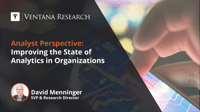Despite all the advances organizations have made with respect to analytics, our most recent research shows the majority of the workforce in the majority of organizations are not using analytics and business intelligence (BI). Less than one-quarter (23%) report that one-half or more of their workforce is using analytics and BI. This is a problem. It means organizations are not enabling their workforce to perform at peak efficiency and effectiveness. It means the workforce in many organizations...
Read More
Topics:
Sales,
embedded analytics,
Analytics,
Business Intelligence,
Data,
Sales Performance Management,
Digital Technology,
Digital Commerce,
natural language processing,
Subscription Management,
partner management,
sales engagement,
revenue management,
Collaborative & Conversational Computing
The industry is making huge strides with artificial intelligence (AI) and machine learning (ML). There is more data available to analyze. Analytics vendors have made it easier to build and deploy models, and AI/ML is being embedded into many types of applications. Organizations are realizing the value that AI/ML provides and there are now millions of professionals with AI or ML in their title or job description. AI/ML is even being used to make many aspects of itself easier. Organizations that...
Read More
Topics:
Sales,
Customer Experience,
Marketing,
Analytics,
Business Intelligence,
Data Preparation,
Digital Technology,
AI & Machine Learning
Fall is a busy time for software industry analysts. It’s a season filled with vendors’ user conferences and some industry conferences. Throughout the course of attending these events I’ve come to the realization that big vendors are often considered the Rodney Dangerfield of the software industry: They get no respect. What I mean by no respect is revealed in snarky social media comments, less enthusiastic coverage by tech media than smaller vendors get and a general sense that big vendors don’t...
Read More
Topics:
Sales,
Software,
R&D
Tibco recently introduced Spotfire 4.0, the most recent version of its interactive discovery and business intelligence (BI) tool. Spotfire comes at BI through visualization. It uses in-memory processing and good user interface design to develop highly interactive displays of data. Version 4.0 attempts to enhance Spotfire’s dashboard capabilities and offers integration with enterprise collaboration tools. The former capabilities are necessary to broaden Spotfire’s appeal and applicability for...
Read More
Topics:
Sales,
Sales Performance,
Social Media,
Spotfire,
Supply Chain Performance,
Analytics,
Business Analytics,
Business Collaboration,
Business Intelligence,
Business Performance,
Chatter,
Collaboration,
Customer & Contact Center,
Dashboards,
Financial Performance,
Tibco,
Twitter,
Workforce Performance
In various forms, business intelligence (BI) – as queries, reporting, dashboards and online analytical processing (OLAP) – is being used increasingly widely. And as basic BI capabilities spread to more organizations, innovative ones increasingly are exploring how to take advantage of the next step in the strategic use of BI: predictive analytics. The trend in Web searches for the phrase “predictive analytics” gives one indication of the rise in interest in this area. From 2004 through 2008, the...
Read More
Topics:
Predictive Analytics,
Predixion,
R,
Revolution Analtyics,
Sales,
Sales Performance,
SAS,
Social Media,
Supply Chain Performance,
Analytics,
Business Analytics,
Business Collaboration,
Business Intelligence,
Business Mobility,
Business Performance,
Business Technology,
CIO,
Cloud Computing,
Customer & Contact Center,
Financial Performance,
IBM SPSS,
Information Builders,
Information Technology,
KXEN,
Netezza,
Oracle,
Workforce Performance
Last week I attended salesforce.com’s Dreamforce user conference in San Francisco (Twitter #DF10). As a user of salesforce applications for the last four years in my previous positions, I was familiar with its analytic capabilities, or lack thereof. Certainly you can accomplish simple reporting and produce dashboards displaying salesforce data, which is adequate for narrowly focused reporting and analysis. However, as a user I was underwhelmed. For example, there are no built-in capabilities...
Read More
Topics:
Sales,
Salesforce.com,
Analytics,
Cloud Computing,
Customer Service,
Uncategorized













